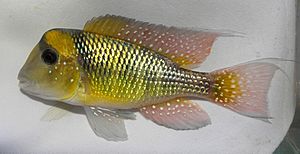Gymnogeophagus mekinos facts for kids
Quick facts for kids Gymnogeophagus mekinos |
|
|---|---|
 |
|
| Scientific classification |
Gymnogeophagus mekinos is a special kind of fish called a cichlid. It lives in parts of the Uruguay and Río Negro rivers in South America. Scientists officially described this fish in 2015.
This fish has some unique features. For example, it does not have certain bones near its spine. It also has a black mark near its top fin that extends onto its back. These features help scientists tell it apart from other similar fish.
Contents
Meet the Mekinos Cichlid
The Gymnogeophagus mekinos is a fascinating freshwater fish. It belongs to a group of fish called geophagine cichlids. These fish are known for their interesting behaviors. They often sift through sand or mud to find food.
Scientists L. R. Malabarba, M. C. Malabarba, and R. E. dos Reis were the ones who first described this species. They gave it its scientific name in 2015.
Where It Lives
The Gymnogeophagus mekinos calls the rivers of South America home. Specifically, it lives in parts of the Uruguay River and the Río Negro River. Both of these rivers are important waterways in Uruguay and Brazil.
These rivers provide a perfect home for the fish. They have fresh water and plenty of places to hide. The riverbeds often have sand or soft mud. This is ideal for cichlids that like to dig and search for food.
What It Looks Like
The Gymnogeophagus mekinos has a distinct look. It is a medium-sized fish for a cichlid. One of its key features is the absence of certain bones. These are called supraneural bones.
It also has a unique spine in its first dorsal fin. This spine points forward. Another special mark is a black spot near the base of its dorsal fin. This spot often reaches up to its back. Unlike some other fish, it does not have a slanted bar between its eye and the back of its head. These details help experts identify this specific fish.
Diet and Behavior
Like many cichlids, the Gymnogeophagus mekinos likely feeds on small things. It probably eats tiny insects, worms, and plant bits. It finds these by sifting through the sand or mud at the bottom of the river. This feeding style is common for "earth-eating" cichlids.
These fish are generally peaceful. However, they can become territorial. This often happens during breeding season. They will protect their space from other fish.
Life Cycle and Reproduction
Cichlids are known for their interesting ways of raising their young. Many species are mouthbrooders. This means the parents keep the eggs and young fish safe inside their mouths. It is not fully known if Gymnogeophagus mekinos does this.
However, most Gymnogeophagus species are substrate spawners. This means they lay their eggs on a flat surface. This could be a rock or a piece of wood. The parents then guard the eggs and young fish. They protect them until they are big enough to swim on their own.
See also
 In Spanish: Gymnogeophagus mekinos para niños
In Spanish: Gymnogeophagus mekinos para niños

